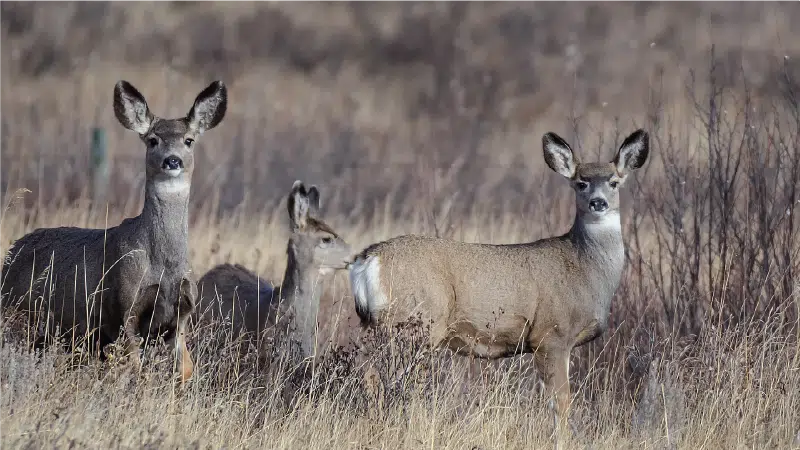By tanka dhakal
Wisconsin Watch
Wearing blue jeans, a short-sleeved button-down shirt and a look of dismay, John Schwarzmann stood near the shore of Whitney Lake in Vilas County, Wisconsin. He didn’t like what he saw so close to the shallow waters where panfish, largemouth bass and northern pike swim: too few trees still standing and too many stumps that loggers left behind.
“Here’s our riparian habitat, and it’s brutally beat up,” he said.
With little shade in this logged section of Northern Highland-American Legion State Forest, the sun beat down on Schwarzmann as the retired state forester walked along one of several northern Wisconsin lakeshores that he and a friend are fighting to protect from state timber harvests.
The state earned $7.5 million from state forest timber sales during the 2022 fiscal year. Most of the trees end up as paper, particle board or lumber, and the state’s proceeds support conservation efforts.
Schwarzmann, of Oneida County, and Ardis Berghoff, a writer in Vilas County and lifelong explorer of Wisconsin’s Northwoods, don’t oppose all logging. But they are protesting the removal of trees near lakeshores, especially native oaks and pines.
Biologists say shoreline trees provide critical protections to lake water quality and ecosystems, filtering out pollutants and providing food, shade and habitats to wildlife.
Healthy plants and trees block harmful runoff from flowing into lakes — an increasingly important task as climate change intensifies rains across the region, said Donald Waller, a retired professor of botany at the University of Wisconsin-Madison.
“People don’t understand the intimate connection between forest and water. But forest and forest quality affects not only the quality of the water, but also the amount of water and how it is released from soils into streams and rivers and springs,” Waller said. “This gets at the heart of the controversy here.”

Cruising across Oneida and Vilas counties in either Schwarzmann’s decades-old Ford Ranger truck or Berghoff’s SUV, the pair closely scrutinizes lakeshore logging operations.
In 2021, 29 of Wisconsin’s 209 state land timber sales occurred near surface water bodies, according to the Department of Natural Resources. The duo surveyed 15 of those lakes that year, alleging that the DNR violated its own environmental standards along nine of them by cutting within 100 feet of high water marks and leaving the remaining trees too thinly spaced along the shoreline.
“When I saw how severely the DNR was logging lakeshores, and how easy it was to find the damage, I knew I had to speak up,” Berghoff said. “No one else was documenting what the DNR was actually doing in an objective and straightforward way.”
The DNR contends that its standards contain flexibility for logging near water in some instances, and it denies any violations. Along Vilas County’s Jute Lake, where Schwarzmann and Berghoff alleged violations during a timber sale years ago, DNR officials blamed a mixup by a logger who had color blindness.
“DNR was following its (best management practices) manual for Riparian Management Zones for Lakes,” Nolan Kriegel, a DNR forester, told Wisconsin Watch in an email. He pointed to a third-party audit supporting that position.
The highly technical dispute has unfolded over a series of audits that may culminate this year with another review: an investigation by the group that accredits the DNR’s auditing firm. Still, the friends have already made an impact: Last year, the DNR reversed plans to cut around 50 to 70 trees along Whitney Lake in response to their concerns.
Those efforts come as the DNR considers updates to its water quality standards for timber sales, with input from an advisory committee. Last updated in 2010, the DNR’s entire field manual for loggers, landowners and land managers is up for an overhaul, with plans to incorporate new scientific findings, including considerations for climate change and storm resiliency, Kriegel said.
Schwarzmann and Berghoff are scrutinizing that process, too. They are concerned that DNR’s 17-member advisory committee includes just two representatives from environmental groups. Representatives from the logging industry, government and other interests fill the remaining seats.
A fight to save the shoreline
Schwarzmann, 60, spent more than half his life managing Wisconsin’s public lands. That included 13 years supervising timber sales, reforestation and auditing best practices for the Wisconsin Board of Commissioners of Public Lands before he retired in 2021. He had no trouble following state standards throughout his career, he said.
“I cut timber my whole career,” he said. “And I love the beauty of it as well. But I like trees, too. Standing.”
Schwarzmann said he first noticed heavy lakeshore logging in 2018. He spotted a surprisingly thin forest buffer along Jute Lake, where musky, panfish and bass entice fishers, but assumed it was an isolated incident.
“My initial reaction was, what’s going on? What’s happening?” he said. “I just thought maybe it was a new forester or somehow somebody wasn’t trained.”
Schwarzmann and Berghoff, 57, began questioning DNR practices two years later. Their self-described “conservation friendship” sprouted years ago, rooted in their love for the forests. They first met when a local forestry cooperative offered a field day on oak wilt, a tree-killing fungus.
Hiking through a section of state forest on Whitney Lake’s west shore in April 2020, they noticed paint markings on trees indicating a DNR timber sale, Berghoff recalled.
“We were astounded at how close they came to the water and, based on the paint colors, how heavily the DNR planned to cut,” she said.

Berghoff threw herself into research and concluded that the DNR was violating its standards.
“The fight to try to save the shoreline began that day,” she said.
Protecting trees to protect water and wildlife
No forest grows completely undisturbed. Naturally occurring wildfires, storms and flooding make sure of that. Still, Wisconsin — like the rest of the Upper Midwest — was covered by old growth forest into its early days of statehood, UW’s Waller said. But as European immigrants industrialized the state, loggers decimated most old growth forests by the 1890s and early 1900s and made Wisconsin the nation’s lumber leader.
“There was severe damage. Landscape was leveled in many places, clear-cut,” Waller said. “There were huge sediment loads going into rivers and lakes.”
Awareness of that destructive history should prompt officials to manage Wisconsin’s forests conservatively — if anything, strengthening standards to protect water, Waller said.
The federal Clean Water Act requires states to create and follow best management practices to limit forestry-related pollution. Wisconsin first developed its standards in 1995 and evaluates their effectiveness in five-year cycles. In 2018, the most recent review, DNR concluded that foresters followed best practices 97.2% of the time during state sales.
The standards generally require 100-foot buffers of trees and vegetation around lakes, designated trout streams and wider streams. Loggers should also leave at least 60 square feet of basal area — a measure of tree trunk area — per acre.
Aside from filtering out pollutants and housing wildlife, shoreline trees prevent soil erosion and absorb heat that might harm wildlife.
Allowing trees to naturally fall into lakes creates fish habitats and spawning grounds that are “really important for species diversity,” said Greg Sass, who leads the fisheries research team in the DNR’s Office of Applied Science.

Wisconsin has lost about a third of its lake whitefish, cisco and other native coldwater fish due to warmer temperatures and land practices — whether due to development, farming or forestry, Sass said.
“That’s another reason we certainly want to be protective of the forests,” he said, adding that he was not commenting on DNR’s forest management.
Waller said the state could learn from the Menominee Indian Tribe of Wisconsin, world-famous for its 150-plus years of sustainable forestry of the Menominee Forest, which spans much of its reservation in Menominee County. Native foresters are typically more selective when cutting. By keeping older native trees, the tribe maintains the largest tract of virgin timberland in the Great Lakes region — untouched by non-Native foresters.
“Today, the Menominee Forest has more volume and contains higher quality trees than it did in 1854 when the reservation was established,” according to the U.S. Forest Service.
Auditing the DNR
DNR contracts an outside firm, SCS Global Services, to review whether its timber sales comply with its standards. That determines whether the state maintains its Forest Stewardship Council certification, which makes Wisconsin timber sales more competitive on the market.
In its 2020 annual review, SCS Global said the DNR met its standards.
But in January 2021, Berghoff complained to SCS Global on behalf of nine local residents. They alleged that the DNR marked too many trees for removal close to Whitney Lake, and that SCS Global’s review failed to address those concerns.
Robert Hrubes, an SCS Global forester and executive vice president emeritus, reviewed the complaint and mostly agreed. He concluded that DNR’s plans failed to designate an adequate forest buffer around Whitney Lake and would leave the remaining trees unevenly distributed. Hrubes directed the DNR to revise its logging plans.
The agency re-marked some shoreline trees originally slated for removal. That preserved as many as 70 trees, Schwarzmann estimates. But the agency pushed back against the findings and asked for a fresh audit.
DNR on defense
By spring 2021, Schwarzmann and Berghoff alleged violations along nine of 15 lakes they surveyed in the Northern Highland-American Legion State Forest. Those included Upper Gresham Lake, about 6 miles south of Whitney Lake, where they flagged logging less than 50 feet from the high water mark.
“This was one of the worst logged tracts we have seen to date,” Schwarzmann and Berghoff wrote in their survey. “This is a clear-cut.”
But in a follow up audit, SCS Global mostly sided with the DNR. The agency successfully argued that its standards allow for thinner forest buffers on certain terrains — as long as water quality was protected.

Logging around Upper Gresham Lake, for instance, might have violated DNR standards, if not for such flexibility, the special auditor found.
The DNR’s manual “does allow for modification of (best management practices) if water quality is not impacted,” and the sites visited lacked “visible evidence” of impacts, the audit said. The agency should strengthen its process for reviewing exceptions, it added.
SCS Global agreed that DNR’s timber sale did not visibly affect water quality. Schwarzmann and Berghoff call the search for visible signs of pollution such as gully erosion — as opposed to measuring water pollutants — an unscientific way to evaluate logging’s impact.
DNR offered a different defense for allowing heavy cutting near Jute Lake during a sale about five years ago: That a logger with color blindness mistook some “leave” trees — marked in green for protection — for trees marked for removal, which are normally painted orange. “Staff detected the error quickly” and marked the trees in different colors, SCS Global’s special audit said, excusing the error.
“We consider it an anomaly,” Michael Warnke, DNR’s deputy administrator for forestry services, told Wisconsin Watch.
SCS Global reversed its corrective action orders, leaving Schwarzmann and Berghoff frustrated.
“This was a slam dunk of a violation,” Schwarzmann said in June as he stood among saplings in a logged section of forest near Upper Gresham Lake. “The auditor should have just seen this and said, ‘I’m done, this is all I need. ”
Auditing the auditor
But Schwarzmann and Berghoff aren’t giving up. They asked Germany-based Assurance Services International, SCS Global’s accreditation body, to audit SCS Global’s work and to visit the shoreline forests at issue. The firm plans to come later this year, an SCS Global official confirmed while declining to offer additional comment.
Meanwhile, the DNR plans to finish updating its best management practices manual by December 2023, weighing input from its advisory committee, which launched last year.
During the committee’s first meeting in October, the friends bristled at the suggestion of Peter Anderson, a forestry consultant on the committee, to drop the 100-foot forest buffer minimum for lakes, according to Berghoff’s notes.
Facing questions from Schwarzmann and Berghoff at a May meeting, however, Anderson said he did not intend to weaken the standards.
The committee has yet to define the scope of its review but “has not expressed any interest in narrowing” the buffer requirement, DNR’s Kriegel told Wisconsin Watch.
Speaking at the May meeting, Berghoff called on the committee to see the logged lakeshores for themselves — to visualize the impact of Wisconsin’s forestry practices. Three members visited Whitney and Upper Gresham lakes, joining Schwarzmann and DNR officials on a trip in late July.

Bethany Polchowski, a procurement forester for Biewer Lumber, was among them. Citing the looming audit, she declined to weigh in on the citizens’ dispute, but said the trip proved productive.
“We had a very good discussion as to interpretations and maybe how we can clean up the manual in the future,” Polchowski said.
Said Schwarzmann, following the visit: “We showed them. Let’s see what they do now.”
How to weigh in on Wisconsin forestry issues
By tanka dhakal
Wisconsin Watch
Want to follow forestry issues in Wisconsin? There are several ways to get involved, said Carmen Hardin of the Department of Natural Resources.
All meetings of the Forestry Best Management Practices Advisory Committee are open to the public, with information available on the DNR’s website. Find the DNR’s full meeting and hearing calendar here.

Those with general questions or concerns about forestry guidance can email ForestryGuidance@wisconsin.gov, Hardin said. Questions about best management practices and water quality? Call DNR Forest Hydrologist Nolan Kriegel at 715-416-2982 or email Nolan.Kriegel@wisconsin.gov.
Find information for commenting on land management activities here, and use this DNR staff directory to find contact information for property managers. Search “property manager” in the subject field.
Jim Malewitz contributed reporting. The nonprofit Wisconsin Watch (www.WisconsinWatch.org) collaborates with WPR, PBS Wisconsin, other news media and the University of Wisconsin-Madison School of Journalism and Mass Communication. All works created, published, posted or disseminated by Wisconsin Watch do not necessarily reflect the views or opinions of UW-Madison or any of its affiliates.
COPYRIGHT 2022 BY CHANNEL 3000. ALL RIGHTS RESERVED. THIS MATERIAL MAY NOT BE PUBLISHED, BROADCAST, REWRITTEN OR REDISTRIBUTED.









